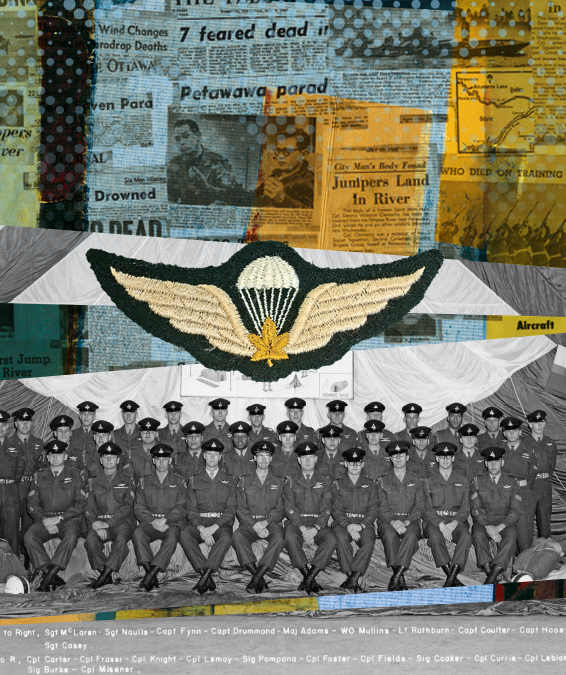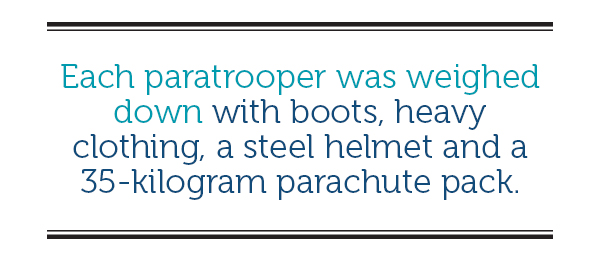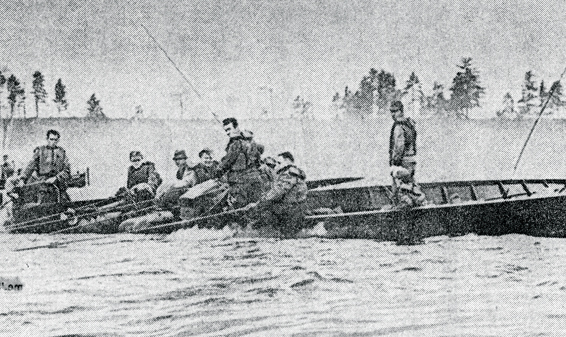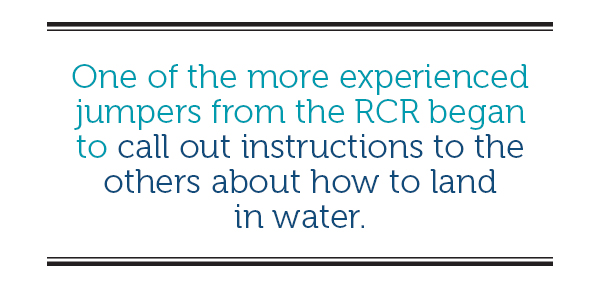
Every May, retired paratroopers, family and friends gather for a small ceremony in Petawawa, Ont., to remember those who died in the worst parachute accident in the history of the Canadian Armed Forces.
Fifty years ago, on May 8, 1968, 26 parachutists jumped from three Buffalo aircraft expecting to land in a drop zone on the Mattawa Plains, a flat sandy stretch of land on Canadian Forces Base Petawawa. Instead, rough winds caught them, sending 22 of them into the frigid Ottawa River. Seven drowned before rescuers could reach them.
“One of the men, Bob Knight, was my best friend. We chummed around quite a bit at the time,” remembered Dennis Stow, who is organizing the 50th anniversary service. “He had five children under the age of four, including two sets of twins.”
The jumpers were members of 2 Airborne Signal Troop based in Petawawa and the parachute section of 1st Royal Canadian Regiment based in London, Ont. While the Canadian Airborne Regiment would be formed later that year in Edmonton, at the time various units of the army had their own paratroop sections.
The military had recently acquired new DHC-5 Buffalo aircraft. Although they would eventually become (and still are) part of Canada’s search-and-rescue forces, these ones were painted with camouflage colours. The military had ordered 15 Buffaloes from de Havilland Canada, the first of which came on service in Montreal in 1967. The short-takeoff-and-landing aircraft were designed to take off from rough airstrips and were first put to use for paratroop training, supply dropping and tactical tasks.
The new Buffalo aircraft were to be used in Exercise New Shakedown, to familiarize parachutists and a number of jumpmasters with the new plane’s features.
“The military wanted to test them for paratroop drops,” said Lance Drummond, a retired lieutenant-colonel living in Kanata, Ont. “I was 2IC [second in command] of the jump crew, so I was asked by the colonel to organize a few days of jumps. It was really the aircraft that was being tested. We were just something to throw out the back door.”
Knowing he had neither enough parachutes in quartermaster’s stores nor enough experienced jumpers in his crew, Drummond made a call to an acquaintance in the RCR in London. “He said, ‘We have plenty of both.’ So a unit drove up from London.”
Drummond said one precaution they always took was to get the engineers to have a boat in the water whenever they jumped on the Mattawa Plains. He ordered two boats: one was in the small Bostwick Lake to the west of the drop zone and the other was in the river. “I remember calling the engineers to get the boats and they said, ‘Who is going to pay the overtime?’ I replied that I didn’t care who pays the overtime, just get the boats in the water.”
Three Buffaloes from 429 Tactical Transport Squadron in St-Hubert, Que., arrived at Petawawa for a series of test drops beginning on Wednesday, May 8.
“They made the first jump in the morning,” recalled Stow, who was assisting at the drop zone that day. “The winds were fine in the morning but they rose in the afternoon and the second jump was cancelled.
“Someone said the winds tend to die down after about 4 o’clock in Petawawa. It was decided to wait a while and the winds did die down—at least on the ground.”
Cpl. Bob Foster of Kingston was one of the jumpers. He remembers “we were just sitting around all afternoon. Then we were told the jump was back on and we got ready.”

Around 8 p.m. the jumpers were on board as the planes took off from Bonnechere airfield south of Pembroke, about 50 kilometres away. “The fellow I was sitting beside got airsick, so he didn’t jump. It’s just how fortune is,” remembered Ken Fynn, who was a captain with the squadron. “The reason he got sick was because we were flying low to test the aircraft. It took half an hour to get to the drop zone but the airport is not that far away.”
The planes reached the target position at 1,250 feet above the drop zone and the paratroopers began to jump. Drummond, who was in the last plane, said they could see the jumpers heading for the water and the order was given to stop the jump.
Still, 26 jumpers had left the planes before the halt was called. Twenty-two of them went into the water off Wegner’s Point at a widening of the Ottawa River about five kilometres across known as Allumette Lake. Although there is a beach nearby, most of the river is deep, reaching down as much as 30 metres. “There’s a reason they call the town up the road Deep River,” said Fynn.
Drummond remained with the planes, which returned to the Bonnechere airfield and then he immediately set out for the drop zone to see what could be done for the jumpers.
Each paratrooper was weighed down with boots, heavy clothing, a steel helmet and a 35-kilogram parachute pack.“I could see that we were heading for the water,” recalled Fynn, who was making his sixth jump, and the first since the five he made in the parachute-training course he had been on earlier that year.
One of the more experienced jumpers from the RCR began to call out instructions to the others about how to land in water. The danger lies in being tangled up in the ropes and silk. The jumper must first untie the safety chute and then unbuckle the harness so that when he is just above the surface, he can let go and fall straight down into the water. “The trick is to go straight down and the chute will blow away when you come back up,” said Fynn.
Fynn succeeded in the manoeuvre. “When I came up, it was still light. I could see the shore maybe 500 metres away and I started swimming. Someone in the water yelled at me to get my helmet off. It was the last thing I needed, two or three pounds weighing down my head.”
The ice on the river had only melted a few weeks before. The temperature of the water was 5°C. “The water was cold, but I grew up swimming in the Bay of Fundy where the water is always cold,” said Fynn.
For Foster, the water landing posed a more serious problem: he couldn’t swim. He too had been on the parachute course that spring and had made the five jumps to qualify. He had jumped that morning and this was his seventh jump.
“I got out of my harness and the wind just took the chute away,” said Foster. “But I had forgotten to take off my helmet. Then a sudden calm came over me. I remembered reading how a soldier had survived a sinking by floating on his helmet. I thought I would try that. I started kicking and found my feet were hitting the bottom. I had landed on a sandbar. The water was up to my chest.
“I thought I would walk to the shore but I took one step and realized I was going over my head. So I just stayed where I was.”
The boat, commanded by Cpl. Ken Armstrong with civilian driver Alex Coulas, began picking up the jumpers. “I was a pretty good swimmer,” said Fynn, “but I had my boots on and my clothes were getting heavy. I called to the boat. I just put my arms up and somebody grabbed me and brought me into the boat.”

Retired colonel Jerry Thomson recalled at the commemoration ceremony in 2008 that he safely got out of his chute when he landed in the water. He saw another soldier struggling and swam over to him. The other soldier was already in shock from hypothermia. The two began to sink together and Thomson was forced to let go. He doesn’t know that man’s fate.
“I think I was the last one they picked up,” said Foster. “The boat was near me, but I could hear someone else struggling in the water.
“I heard someone shout, ‘Are you OK, Bob?’ I said, ‘I’m OK but you better get that soldier who is treading water.’”
As the officers began counting their men, messages went back and forth to find out how many had left the planes. Fifteen had been pulled out of the water. “I still cannot help thinking, what if I hadn’t insisted on that boat being on the river?” said Drummond. Still, it soon became evident that seven were still missing, and darkness had set in.
Stow and others spent the night searching. By morning, a full rescue operation was in place. The base provost officers and fire department had set up a communication system. The 2nd Canadian Guards had mobilized and were searching the shores. Combat divers and the base diving club were brought in and more boats were put into the water.
The search operation was led by Lieutenant-Colonel H.P. Hanson of 2nd Canadian Guards. Three fixed-wing aircraft and a helicopter from CFB Petawawa and one search-and-rescue helicopter from CFB Trenton, nearly 300 kilometres away, were brought in. An eight-kilometre stretch of the Ottawa River was searched by more than 300 base personnel and volunteers.
News of the accident spread quickly through the community. “I made one bad mistake that night—I didn’t call home. It’s a small community and when something like this happens, word spreads quickly,” said Drummond.
Reporters from the Pembroke Observer interviewed two of the soldiers’ wives who came to help. “I thought about the possibility of something like this happening but he loves jumping, so I didn’t try to discourage him,” said the unnamed wife of Cpl. Hugh Fields of 2 Sigs.
In the early morning, the body of RCR Warrant Officer Mike McDonnell, 41, was found with his equipment intact. It was his 400th jump. Shortly afterward, searchers found Cpl. Dennis Clements, 27, of 2nd Sigs and Master Warrant Officer Reg Riddell, 36, of the RCR.
Cpl. Bob Knight, 27, was found the next day, May 10. He had been attempting to escape from his chute when he drowned. The body of Cpl. Hugh Fields, 35, was found on Saturday, May 11, along with that of Cpl. Jim Misener, 24, of 2 Sigs, and Cpl. Bruce Chiswell, 30, of the RCR. All seven of the missing had drowned.
A week after the jump, a sunset ceremony was held at 8:10 p.m. on the Mattawa Plains. More than 1,500 troops participated and 1,000 civilians attended. A Royal Canadian Artillery gun crew fired a single shot and a firing party fired three volleys. “Last Post” was played, followed by “Lament” played by a piper from the Canadian Guards standing on the riverbank with his feet at the water’s edge.
Each deceased man’s name, rank and regimental number were read aloud, followed by the phrase, “Died in the service of Canada” in English and French.
The men in 2 Sigs had a “confidence jump” about a week after that. Two twin-engine Otters were used for the men to complete a successful jump after the tragedy. It was said their fallen comrades would have expected nothing less.

A board of inquiry was called into the accident and the contents of its review were reported in the Ottawa Journal. No blame was laid. Winds were at an acceptable level at both aircraft altitude and on the ground. However, there were unexpected winds at about 600 feet that pushed the men eastward toward the river.
“The inquiry went up to Deep River [where scientists at the nuclear facility record all the wind trends]. They found that there was a wind sheer that pushed the men to the east,” said Drummond.
The inquiry made several recommendations, including that flotation equipment be used for jumps within one mile of water, improved wind-measuring equipment be used, the number of safety boats be increased, better control and communications procedures be implemented, and all drop zones be examined to ensure they meet modern requirements.
The drowned men’s remains were returned to their hometowns for burial. Fynn and Foster escorted the body of Clements to Saint John, N.B., which was Fynn’s hometown as well.
The military wanted people to know what happened, so Fynn and Lieutenant Richard Rathburn, one of the few who had landed on shore, gave press interviews when requested.
On July 14, a cairn was erected and dedicated in an evening ceremony. It is to that cairn that family and friends return every year on a Sunday close to the May 8 anniversary.
The ceremony is not elaborate. There are speeches by dignitaries, prayers, “Last Post” is played and wreathes are placed. Lunch, often at Petawawa Branch of the Legion, follows. “I usually arrange for lunch for 100,” said Stow.
He had been away from the base for years, serving in Europe and elsewhere before retiring to Pembroke. In 2010, he took over organizing the ceremony. There was talk of discontinuing the ceremony. The Canadian Airborne Association organized it for a while but it was unable to continue and, as Stow points out, the accident happened before the Airborne was formed. “I said, as long as I am able, there will be a ceremony. “I think we owe it to the families.”
Advertisement













